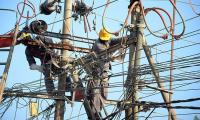LAHORE: The exuberance displayed by the economic squad belies normal economic principles as they are expecting buoyancy, when investment is contracting, the government is cannibalising the meager development budget to cover revenue shortfall, and energy as well as power is growing dearer, etc.
Growth comes from development spending, establishment of green-field projects and availability of inputs at globally competitive rates.
This government has drastically reduced the development budget and on top of that is making up the shortfall in revenues by further curtailing the budgeted development expenses.
Energy and power are the two most important inputs of any manufacturing process. Today, barring five exporting sectors, the power and energy rates in Pakistan are the highest in the region. The exporting industries are also dashing from pillar to post to get their energy and power bills aligned to the tariff notified for them by the federal government. Entrepreneurs are not going for expansion or are holding back new project investments. They are rather making hectic efforts to at least hold onto their already throttled production activities.
Things are not as simple as the economic managers are trying to have us believe. The foreign exchange reserves dipped over $700 million this week, despite the fact the central bank was able to attract hot money worth $239 million. Influx of foreign exchange through loans is not going to solve our foreign exchange problem. Imports are so low that a further compression would not be possible.
The exports are stagnant. People are not buying the lollypop the quantity of exports has increased but the value has not. What we desperately need is the increase in value of exports. In the same way the contention of Federal Board of Revenue (FBR) that it missed the revenue target because imports contracted by $3 billion in first quarter is not a plausible excuse. The imports declined as per the policy of the FBR.
There were other factors that boosted revenues. The rupee declined after the presentation of budget by almost 5 percent, while inflation has doubled in one year. These two factors facilitated increase in revenues.
There was 13 percent increase in revenues in the first quarter and the government’s target is to increased total revenues by over 30 percent by year-end. This government is still dilly dallying on reforms. The CNIC (computerised national identity card) condition has neither been withdrawn nor enforced.
The retailers have refused to pay the fixed tax and the FBR is inviting them to the table. Though the incidence of under-invoicing has declined the smuggling is still going on unabated. The issue of under-reporting of production has not been addressed that puts those manufacturers that report actual production at disadvantage.
Under these circumstances we frequently hear some government circles claiming the truncated growth target of 2.4 percent of GDP fixed at the time of presentation of budget would be exceeded. How is that even possible? We are going to drastically reduce the development expenditure as it is now clear the revenue target of Rs5.5 trillion would not be met.
We may reduce the primary deficit through privatisation proceeds but for how long? The pressure on interest rates is going to stay for a while as the inflation has not yet started easing.
That means the chances of increase in investment are very low. News from the agriculture front is not encouraging. Take cotton for instance, the production of which fell 29 percent less from the first peak.
People walk out of a branch of Mashreq bank at Dubai Internet City on Feb. 5, 2012. — Reuters/FileKARACHI: Mashreq...
A Dubai Islamic Bank building seen in this undated photo. — The News/File KARACHI: Dubai Islamic Bank Pakistan...
The image shows the logo of the Securities and Exchange Commission of Pakistan . — APP/FileISLAMABAD: The Securities...
A representational image of gold bangles. — AFP/FileKARACHI: Gold prices in the local market dropped by Rs500 per...
This representational image shows the Electric Cars. — Unsplash/FileNew York: Global policymakers are imposing new...
This image portrays a "Tax Return" written by a typewriter. — Unsplash/FileLAHORE: The government is planning to...







